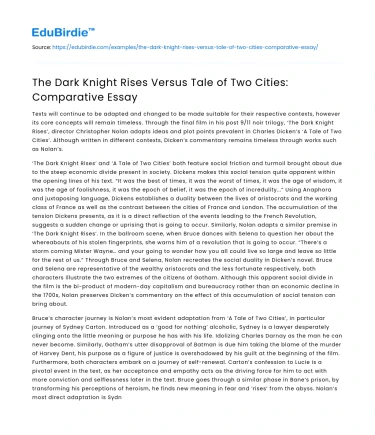Texts will continue to be adapted and changed to be made suitable for their respective contexts, however its core concepts will remain timeless. Through the final film in his post 9/11 noir trilogy, ‘The Dark Knight Rises’, director Christopher Nolan adapts ideas and plot points prevalent in Charles Dicken’s ‘A Tale of Two Cities’. Although written in different contexts, Dicken’s commentary remains timeless through works such as Nolan’s.
‘The Dark Knight Rises’ and ‘A Tale of Two Cities’ both feature social friction and turmoil brought about due to the steep economic divide present in society. Dickens makes this social tension quite apparent within the opening lines of his text. “It was the best of times, it was the worst of times, it was the age of wisdom, it was the age of foolishness, it was the epoch of belief, it was the epoch of incredulity...” Using Anaphora and juxtaposing language, Dickens establishes a duality between the lives of aristocrats and the working class of France as well as the contrast between the cities of France and London. The accumulation of the tension Dickens presents, as it is a direct reflection of the events leading to the French Revolution, suggests a sudden change or uprising that is going to occur. Similarly, Nolan adapts a similar premise in ‘The Dark Knight Rises’. In the ballroom scene, when Bruce dances with Selena to question her about the whereabouts of his stolen fingerprints, she warns him of a revolution that is going to occur. “There’s a storm coming Mister Wayne… and your going to wonder how you all could live so large and leave so little for the rest of us.” Through Bruce and Selena, Nolan recreates the social duality in Dicken’s novel. Bruce and Selena are representative of the wealthy aristocrats and the less fortunate respectively, both characters illustrate the two extremes of the citizens of Gotham. Although this apparent social divide in the film is the bi-product of modern-day capitalism and bureaucracy rather than an economic decline in the 1700s, Nolan preserves Dicken’s commentary on the effect of this accumulation of social tension can bring about.
Save your time!
We can take care of your essay
- Proper editing and formatting
- Free revision, title page, and bibliography
- Flexible prices and money-back guarantee
Bruce’s character journey is Nolan’s most evident adaptation from ‘A Tale of Two Cities’, in particular journey of Sydney Carton. Introduced as a ‘good for nothing’ alcoholic, Sydney is a lawyer desperately clinging onto the little meaning or purpose he has with his life. Idolizing Charles Darnay as the man he can never become. Similarly, Gotham’s utter disapproval of Batman is due him taking the blame of the murder of Harvey Dent, his purpose as a figure of justice is overshadowed by his guilt at the beginning of the film. Furthermore, both characters embark on a journey of self-renewal. Carton’s confession to Lucie is a pivotal event in the text, as her acceptance and empathy acts as the driving force for him to act with more conviction and selflessness later in the text. Bruce goes through a similar phase in Bane’s prison, by transforming his perceptions of heroism, he finds new meaning in fear and ‘rises’ from the abyss. Nolan’s most direct adaptation is Sydney’s speech before his death, “It is a far, far better thing that I do, than I have ever done; it is a far, far better rest I go to than I have ever known”. After years of purposelessness and degeneracy, through his sacrifice for the wrongly accused of France, he feels a sense of accomplishment and real purpose in his life. Similarly, Jim Gordon’s recital of this line during Bruce’s funeral is symbolic of the Dark Knight’s renewed legacy, his sacrifice gave Bruce the peace he needed and the people of Gotham freedom. Nolan’s adaptation of Sydney Carton’s character archetype reinforces how texts can be adapted to suit the needs of differing contexts but still retaining its original meaning.
Ultimately, Nolan’s heavy inspiration and adaptation of Dickens’ work is an exemplar on the role of adaptation and appropriation in literature. By successfully adopting similar storytelling beats and character archetypes from ‘A Tale of Two Cities’ and adapting it into his film ‘The Dark Knight Rises’, he showcases how ideas and concepts can continually evolve and morph but still retain some of its original meaning.






 Stuck on your essay?
Stuck on your essay?

